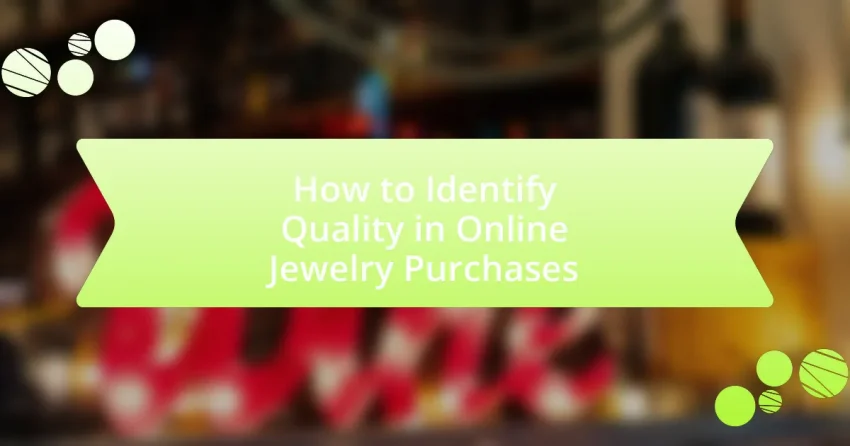The article focuses on identifying quality in online jewelry purchases, emphasizing the importance of examining materials, craftsmanship, and certifications. Key indicators of quality include the authenticity of materials, detailed craftsmanship, and customer reviews. The article outlines how to assess the authenticity of gemstones and metals, the significance of jewelry certifications, and the factors influencing pricing. Additionally, it provides practical tips for enhancing the online shopping experience, ensuring safety, and maintaining jewelry quality after purchase. Understanding these elements is crucial for consumers to make informed decisions and avoid potential pitfalls when buying jewelry online.

How can you determine the quality of jewelry when shopping online?
To determine the quality of jewelry when shopping online, examine the materials, craftsmanship, and certifications provided by the seller. High-quality jewelry typically uses precious metals like gold, silver, or platinum, and genuine gemstones, which should be clearly stated in the product description. Additionally, look for detailed images that showcase the craftsmanship, including close-ups of settings and finishes. Certifications from reputable organizations, such as the Gemological Institute of America (GIA) for diamonds, provide assurance of the authenticity and quality of the stones. Reviews and ratings from previous customers can also offer insights into the product’s quality and the seller’s reliability.
What are the key indicators of quality in online jewelry purchases?
The key indicators of quality in online jewelry purchases include the authenticity of materials, craftsmanship, and customer reviews. Authenticity can be verified through certifications such as GIA for diamonds or hallmark stamps for precious metals, ensuring that the materials are genuine and meet industry standards. Craftsmanship is assessed by examining product images for details like setting quality and finishing, which reflect the skill involved in creating the piece. Customer reviews provide insights into the experiences of previous buyers, highlighting aspects such as durability and satisfaction, which are critical for evaluating overall quality.
How does the material used affect the quality of jewelry?
The material used significantly affects the quality of jewelry by determining its durability, appearance, and overall value. High-quality materials, such as gold, platinum, and genuine gemstones, provide greater resistance to wear and tarnish, ensuring longevity and maintaining aesthetic appeal. For instance, 18-karat gold contains a higher percentage of pure gold compared to lower karats, resulting in a richer color and better resistance to scratching. Additionally, the use of authentic diamonds versus synthetic alternatives impacts both the visual brilliance and market value, as natural diamonds are often more sought after. Therefore, the choice of material directly correlates with the jewelry’s quality, influencing both its physical properties and consumer perception.
What role does craftsmanship play in determining jewelry quality?
Craftsmanship is crucial in determining jewelry quality as it directly influences the durability, aesthetic appeal, and overall value of the piece. High-quality craftsmanship ensures precise detailing, proper setting of gemstones, and the use of superior materials, which collectively enhance the jewelry’s longevity and visual impact. For instance, well-crafted jewelry often features smooth finishes, secure clasps, and consistent metal thickness, which are indicators of skilled artisanship. According to a study by the Gemological Institute of America, jewelry that exhibits meticulous craftsmanship tends to retain higher resale value, underscoring its importance in assessing quality.
How can you assess the authenticity of gemstones and metals?
To assess the authenticity of gemstones and metals, utilize gemological testing and certification from reputable laboratories. Gemological testing involves examining the physical and optical properties of gemstones, such as refractive index, specific gravity, and spectral analysis, which can differentiate natural stones from synthetics or imitations. For metals, testing methods like acid tests, electronic testers, and X-ray fluorescence can confirm the metal’s purity and authenticity. Certification from recognized organizations, such as the Gemological Institute of America (GIA) or the International Gemological Institute (IGI), provides documented proof of a gemstone’s authenticity and quality, ensuring that the buyer receives a genuine product.
Why is it important to understand jewelry certifications?
Understanding jewelry certifications is crucial because they provide verified information about the quality and authenticity of gemstones and precious metals. Certifications from reputable organizations, such as the Gemological Institute of America (GIA) or the International Gemological Institute (IGI), ensure that consumers are informed about the characteristics of their jewelry, including cut, clarity, color, and carat weight for diamonds. This knowledge helps buyers make informed decisions, avoid scams, and assess the true value of their purchases, as certified pieces typically retain higher resale value and are more likely to meet consumer expectations.
What are the most recognized jewelry certifications?
The most recognized jewelry certifications include the Gemological Institute of America (GIA), the American Gem Society (AGS), and the International Gemological Institute (IGI). These organizations are known for their rigorous grading standards and comprehensive education in gemology. The GIA, for instance, is widely regarded as the gold standard in diamond grading, providing detailed reports on cut, color, clarity, and carat weight. The AGS focuses on the quality of cut in diamonds and offers a grading system that is highly respected in the industry. The IGI provides certification for a variety of gemstones and jewelry, ensuring authenticity and quality. These certifications are essential for consumers to verify the quality and value of their jewelry purchases.
How do certifications impact the perceived value of jewelry?
Certifications significantly enhance the perceived value of jewelry by providing assurance of quality and authenticity. When jewelry is certified by reputable organizations, such as the Gemological Institute of America (GIA) or the American Gem Society (AGS), it indicates that the piece has been evaluated for its quality, including factors like cut, clarity, color, and carat weight. This verification process instills confidence in consumers, leading to a higher willingness to pay for certified pieces. For instance, a GIA-certified diamond can command prices that are 10% to 30% higher than non-certified diamonds, reflecting the added trust and value associated with certification.
What should you look for in online jewelry retailers?
When evaluating online jewelry retailers, you should look for transparency in product descriptions, including detailed information about materials, craftsmanship, and certifications. Reliable retailers provide clear images, customer reviews, and return policies, which enhance trust and ensure quality. For instance, retailers that offer certifications from recognized gemological institutes, such as the Gemological Institute of America (GIA), demonstrate a commitment to quality and authenticity. Additionally, a secure payment process and responsive customer service are essential indicators of a reputable online jewelry retailer.
How can customer reviews help in assessing retailer reliability?
Customer reviews are essential for assessing retailer reliability as they provide firsthand accounts of customer experiences with the retailer. These reviews often highlight aspects such as product quality, shipping times, and customer service responsiveness, which are critical indicators of a retailer’s trustworthiness. For instance, a study by BrightLocal in 2022 found that 91% of consumers read online reviews regularly, and 84% trust them as much as personal recommendations. This data underscores the significant impact of customer feedback on perceived reliability, as consistent positive reviews can enhance a retailer’s reputation, while negative reviews can raise red flags about their reliability.
What return policies should you consider when purchasing jewelry online?
When purchasing jewelry online, consider return policies that allow for a full refund or exchange within a specified period, typically 30 to 60 days. These policies should also cover the condition of the item, ensuring that returns are accepted if the jewelry is unworn and in its original packaging. Additionally, check if the retailer provides free return shipping, as this can significantly reduce the cost and hassle of returning items. According to a survey by the National Retail Federation, 66% of consumers consider return policies when making online purchases, highlighting the importance of flexible and customer-friendly return options in the jewelry market.

How do you evaluate the price of online jewelry?
To evaluate the price of online jewelry, compare the cost against factors such as material quality, craftsmanship, brand reputation, and market trends. High-quality materials like gold, platinum, and genuine gemstones typically command higher prices due to their intrinsic value and durability. Craftsmanship, which includes the skill involved in creating the piece, also influences pricing; well-crafted jewelry often features intricate designs and attention to detail. Brand reputation plays a significant role, as established brands may charge a premium for their name and perceived quality. Additionally, researching current market trends can provide insights into fair pricing, as prices can fluctuate based on demand and availability. For instance, a study by the Gemological Institute of America highlights that the value of diamonds can vary significantly based on the four Cs: cut, color, clarity, and carat weight, which are essential in determining their market price.
What factors influence the pricing of jewelry online?
The pricing of jewelry online is influenced by several key factors, including material quality, brand reputation, design complexity, and market demand. Material quality, such as the type of metal (gold, silver, platinum) and gemstone (diamond, sapphire, etc.), directly affects the cost, as higher-quality materials command higher prices. Brand reputation plays a significant role, as established brands often charge a premium due to perceived value and trust. Design complexity also impacts pricing; intricate designs or custom pieces typically require more labor and skill, leading to higher costs. Lastly, market demand can fluctuate based on trends and consumer preferences, influencing pricing strategies. For instance, according to a report by Statista, the global jewelry market was valued at approximately $348 billion in 2020, reflecting the significant impact of these factors on pricing.
How does market demand affect jewelry prices?
Market demand directly influences jewelry prices by determining how much consumers are willing to pay for specific pieces. When demand increases, prices typically rise due to the scarcity of available items and heightened competition among buyers. For instance, during economic upturns or holiday seasons, demand for jewelry often surges, leading to higher prices. Conversely, when demand decreases, such as during economic downturns, prices tend to fall as sellers lower prices to attract buyers. Historical data shows that luxury jewelry prices can fluctuate significantly based on market trends, with a 2021 report indicating that high-end jewelry prices increased by 10% due to rising consumer interest and limited supply.
What is the significance of comparing prices across different retailers?
Comparing prices across different retailers is significant because it enables consumers to identify the best value for their purchases. By analyzing price variations, shoppers can uncover substantial savings, as studies indicate that price differences for the same product can range from 10% to 30% among various retailers. This practice not only helps in making informed purchasing decisions but also encourages competitive pricing, ultimately benefiting consumers in terms of cost efficiency and quality assurance in their online jewelry purchases.
Why is it essential to understand the difference between retail and wholesale prices?
Understanding the difference between retail and wholesale prices is essential because it directly impacts purchasing decisions and profit margins. Retail prices are the final prices consumers pay, reflecting the cost of goods plus markup for profit, while wholesale prices are the lower rates charged to retailers or bulk buyers, allowing them to resell at a profit. This distinction helps consumers identify fair pricing and assess the value of jewelry, ensuring they are not overpaying based on inflated retail markups. Additionally, knowledge of these price structures enables buyers to make informed choices about where to purchase jewelry, whether from retailers or directly from wholesalers, ultimately influencing their overall satisfaction and financial outcomes in online jewelry purchases.
How can wholesale prices indicate quality or value?
Wholesale prices can indicate quality or value by reflecting the cost of materials, craftsmanship, and market demand. Higher wholesale prices often correlate with superior materials, such as genuine gemstones or precious metals, which are more expensive to source and manufacture. For instance, a wholesale price of $500 for a gold necklace suggests that the gold content and design quality are likely higher than a necklace priced at $100, which may use lower-quality materials or mass production techniques. Additionally, established brands may set higher wholesale prices due to their reputation for quality, further signaling value to consumers.
What are the risks of purchasing jewelry at significantly lower prices?
Purchasing jewelry at significantly lower prices carries risks such as the likelihood of receiving counterfeit or substandard products. Jewelry priced well below market value often indicates inferior materials, such as synthetic stones instead of genuine gems, or low-quality metals that may tarnish quickly. According to a report by the Gemological Institute of America, many online retailers selling jewelry at steep discounts may not provide proper certification for their gemstones, leading to potential misrepresentation of value. Additionally, lower prices can suggest a lack of ethical sourcing, raising concerns about labor practices and environmental impact.

What practical tips can enhance your online jewelry shopping experience?
To enhance your online jewelry shopping experience, prioritize researching the seller’s reputation and product reviews. Verified customer feedback provides insights into the quality and authenticity of the jewelry, helping you make informed decisions. Additionally, ensure that the website offers clear return policies and guarantees, as these protect your purchase and allow for exchanges if the item does not meet your expectations. Utilizing high-quality images and detailed descriptions can also aid in assessing the jewelry’s craftsmanship and materials, which is crucial for identifying quality.
How can you ensure a safe online shopping experience for jewelry?
To ensure a safe online shopping experience for jewelry, shop only from reputable websites that provide secure payment options. Reputable websites often display security certifications, such as SSL encryption, which protects your personal and financial information during transactions. Additionally, verify the seller’s return policy and customer reviews to assess their reliability. According to a 2021 survey by the Better Business Bureau, 70% of consumers reported feeling more secure when shopping on sites with clear return policies and positive reviews.
What security measures should you look for on jewelry websites?
When evaluating jewelry websites, look for security measures such as SSL encryption, which ensures that data transmitted between the user and the website is secure. SSL certificates are indicated by a padlock icon in the browser’s address bar and a URL that begins with “https://”. Additionally, reputable jewelry websites should offer secure payment options, including well-known payment gateways that provide buyer protection. Websites should also have clear privacy policies outlining how customer data is handled and protected. Furthermore, look for customer reviews and ratings, as these can indicate the website’s reliability and security practices.
How can you verify the legitimacy of an online jewelry store?
To verify the legitimacy of an online jewelry store, check for secure website protocols, such as HTTPS, and look for customer reviews on independent platforms. Secure websites protect your personal information, while customer reviews provide insights into the store’s reputation and product quality. Additionally, confirm the store’s contact information and return policy, as legitimate businesses typically offer clear communication channels and fair return options. Researching the store’s business registration and any certifications, such as those from the Gemological Institute of America, can further validate its authenticity.
What are the best practices for maintaining quality after purchase?
To maintain quality after purchasing jewelry online, it is essential to follow specific best practices. First, store the jewelry properly by keeping it in a cool, dry place, ideally in a soft pouch or a jewelry box to prevent scratches and tangling. Regular cleaning is crucial; use a soft cloth to wipe the jewelry after each wear to remove oils and dirt, and follow manufacturer guidelines for deeper cleaning. Additionally, schedule periodic professional inspections to check for loose stones or damage, ensuring the integrity of the piece. These practices help preserve the jewelry’s appearance and longevity, supported by the fact that proper care can extend the life of jewelry significantly, as noted by the Jewelers of America, which emphasizes maintenance as key to sustaining quality.
How should you care for different types of jewelry materials?
To care for different types of jewelry materials, specific cleaning and storage methods should be employed. For gold and silver, use a soft cloth to wipe away tarnish and store in a dry, cool place to prevent oxidation. For gemstones, clean with a mild soap solution and a soft brush, avoiding harsh chemicals that can damage the stone. Pearls require special attention; they should be wiped with a damp cloth after wearing and stored separately to avoid scratching. For costume jewelry, avoid exposure to moisture and store in a dry environment to maintain their appearance. These care methods are essential to prolong the life and maintain the quality of various jewelry materials.
What common mistakes should you avoid to preserve jewelry quality?
To preserve jewelry quality, avoid exposing it to harsh chemicals, which can cause tarnishing and damage. Jewelry should not be cleaned with abrasive materials or stored in damp environments, as moisture can lead to corrosion. Additionally, wearing jewelry during physical activities can result in scratches and breakage. Proper storage in a dry, soft-lined box or pouch can prevent tangling and scratching. Regular maintenance, such as professional cleaning, is essential to keep jewelry in optimal condition.
